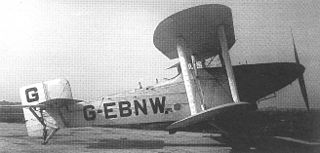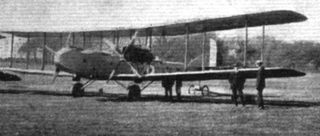Related Research Articles

The Avro 549 Aldershot was a British single-engined heavy bomber aircraft built by Avro.

The Avro 566 Avenger was a prototype British fighter of the 1920s, designed and built by Avro. It was a single-seat, single-engine biplane of wood and fabric construction. Although it was a streamlined and advanced design, it never entered production.

The Avro Cadet is a single-engined British biplane trainer designed and built by Avro in the 1930s as a smaller development of the Avro Tutor for civil use.

The Avro Club Cadet was a 1930s single-engined British biplane trainer aircraft, designed and built by Avro as a development of the earlier Cadet. It was planned for private and club use and, unlike the Cadet, was fitted with folding wings.

The Avro 571 Buffalo was a prototype British carrier-based torpedo bomber biplane, designed and built by Avro in the 1920s. It was not selected for service, the Blackburn Ripon being ordered instead.

The Avro 604 Antelope was a British light bomber which was designed and built in the late 1920s to meet a requirement for a light bomber to equip the Royal Air Force, competing against the Hawker Hart and the Fairey Fox II. It was unsuccessful, the Hart being preferred.

The Avro 627 Mailplane was a British biplane developed in 1931 by Avro from the Avro Antelope bomber as a mail plane for use in Canada. Only one was built which ended up being used as a test bed.
The Avro 636 was a single-engined British fighter-trainer built by Avro in the mid-1930s. Four were built for the Irish Air Corps.

The Avro 641 Commodore was a British single-engine five-seat cabin biplane built by Avro in the mid-1930s for private use. A total of only six were built, including the prototype.

The Avro Type E, Type 500, and Type 502 made up a family of early British military aircraft, regarded by Alliott Verdon Roe as his firm's first truly successful design. It was a forerunner of the Avro 504, one of the outstanding aircraft of the First World War.

The Avro 510 was a two-seat racing seaplane designed by Avro to compete in the 1914 Circuit of Britain Race. It was a conventional two-bay biplane of greatly uneven span, equipped with two large central floats and two outriggers. The race was called off at the outbreak of the First World War, but the British Admiralty was aware of the type and ordered five examples, with modified floats and tail. In service, these proved completely unsuitable, and it was discovered that with a second person aboard, the aircraft could barely fly. In October 1915, the 510s in service were sent to Supermarine for modification and improvement, but by March the following year all were removed from service.

The Avro 523 Pike was a British multi-role combat aircraft of the First World War that did not progress past the prototype stage. It was intended to provide the Royal Naval Air Service with an anti-Zeppelin fighter that was also capable of long-range reconnaissance and bombing.

The Avro 534 Baby was a British single-seat light sporting biplane built shortly after the First World War.

The Airco DH.3 was a British bomber aircraft of the First World War. The DH.3 was designed in 1916 as a long-range day bomber by Geoffrey de Havilland, chief designer at the Aircraft Manufacturing Company. It was a large biplane with wide-span three-bay wings, slender fuselage, and a curved rudder. It was powered by two 120 hp (89 kW) Beardmore engines, mounted as pushers between the wings. In addition to tailskid landing gear, two wheels were placed under the nose to prevent it from tipping over on the nose.

The Avro Type 557 Ava was a British twin-engined biplane torpedo bomber of the 1920s. It was developed by Avro to meet a requirement for a heavy torpedo bomber for the Royal Air Force but was unsuccessful, only two prototypes being built.

The Avro 530 was a British two-seat fighter biplane designed in 1916 to compete with the Bristol F.2A. The plane was first flown in July 1917. It was of fabric-covered wooden construction, powered by a 200 hp (150 kW) Hispano-Suiza engine.
The Avro 527 was the last Avro two-seat fighter derivative of the basic 504 design. It was built early in 1916 for trial by the Royal Flying Corps, with the features of the Royal Naval Air Service (RNAS) Avro 504G but with a much more powerful engine; it did not reach production.

The Avro 562 Avis was a two-seat light biplane designed and built by A.V.Roe and Company Limited at Hamble for the 1924 Lympne Light Aeroplane Trials.

The Avro 529 was a twin-engined biplane long-range bomber of the First World War. Two prototypes were built but no production ensued.
The Avro 528 was an unsuccessful large span single-engined biplane built to an Admiralty contract in 1916. It carried a crew of two; only one was built.
References
- ↑ Jackson 1990, p.142.
- Jackson, A.J. (1990). Avro Aircraft since 1908. London: Putnam. ISBN 0-85177-834-8.
- Mason, Francis K. (1994). The British Bomber since 1912. London: Putnam. ISBN 0-85177-861-5.
- Taylor, Michael J. H. (1989). Jane's Encyclopedia of Aviation. London: Studio Editions. p. 93.
- Shores, Christopher (1984). History of the Royal Canadian Air Force. Toronto: Royce. p. 18. ISBN 0-86124-160-6.